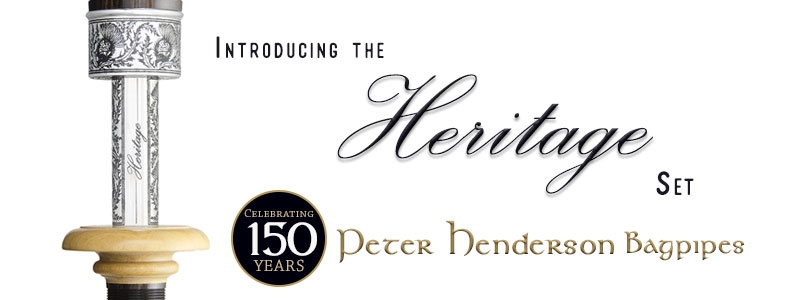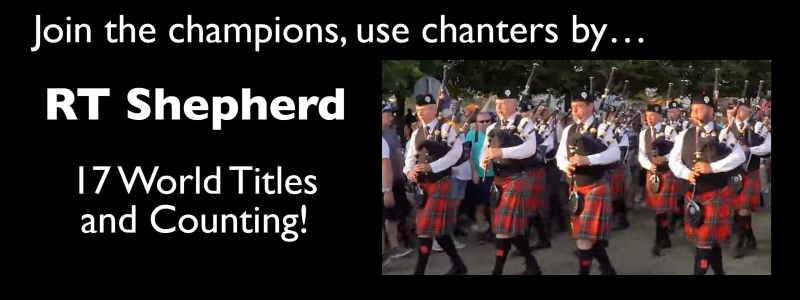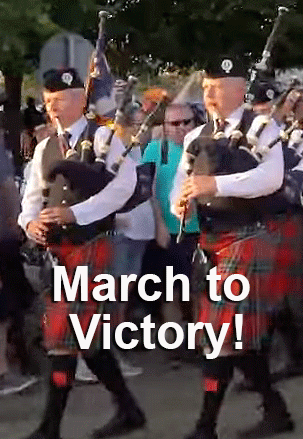Alistair Aitken continues with part four in his series beginning with….
The Royal Highland Fusiliers
The Royal Highland Fusiliers (RHF) were formed in 1959 as a result of the amalgamation of the Royal Scots Fusiliers (21st) and the Highland Light Infantry (71st, 73rd and 74th). The Royal Scots Fusiliers, the 21st Foot, were raised in 1678 by the 5th Earl of Mar. The regiment’s first engagement was the Battle of Walcourt in 1689. By 1695 it was officially known as the Scots Fusiliers and the regiment achieved Royal status in 1712. One of the regiment’s nicknames was ‘Marlborough’s Own’ as a result of distinguished service under the Duke of Marlborough between 1702 and 1712. During this time the regiment fought in the Battles of Blenheim and Ramilles amongst others. As a result of the Cardwell Reforms of 1881 the regiment became known officially as the County Regiment of Ayrshire.
One of the star pipers to emerge from that county and who served with the regiment with distinction was P/M Gordon Walker one of the top pipers in the world today. Another, now retired from competitive piping, was Major Gavin Stoddart who joined the RHF from the Scots Guards and went on to become a distinguished and long-serving Director of Army Bagpipe Music at Edinburgh Castle and then latterly at Inchdrewer House.
The 73rd Highlanders were raised by John MacKenzie, Lord Macleod, as the first clan regiment in 1777 in response to the American War of Independence. In 1786 it became the 71st Highlanders. The 74th Highlanders were formed in 1787 as a result of the War in India. As a result of the Cardwell reforms in 1881 the 71st and 74th were linked as the 1st and 2nd Battalions of the Highland Light Infantry. In 1923 the regiment became known officially as the City of Glasgow Regiment. The next reforms of infantry regiments resulted in the formation in 1959 of the Royal Highland Fusiliers (Princess Margaret’s Own Glasgow and Ayrshire Regiment).
The regiment has seen action in many battles, from Blenheim in the early 1700s to the Gulf War and Afghanistan. Battle Honours include Blenheim (August 1704 – War of the Spanish Succession); Assaye (September 1803 – Mahratta War); the Storming of Badajoz (April 1812 – Peninsular War); Vittoria (June 1813 – Peninsular War); Waterloo (July 1815); Inkerman (November 1854 – Crimean War); and Gheluvelt (October 1914 – World War I, France).
Since 2006 the RHF have been known as 2 SCOTS The Royal Highland Fusiliers as part of the Royal Regiment of Scotland.
The Black Watch
The Black Watch was raised in the wake of the 1715 Jacobite rebellion, when companies of trustworthy Highlanders were drawn from loyal clans comprising Campbells, Grants, Frasers and Munros. Six companies were then formed in 1725 and stationed in small detachments across the Highlands to prevent fighting between clans, to deter raiding and to help enforce laws against the carrying of weapons. In 1739 King George II authorised the raising of four additional companies to be formed into a ‘Regiment of the Line’ of the regular army, with the Earl of Crawford as Colonel. The first mustering of the new Black Watch regiment took place near Aberfeldy the following year. The Black Watch name was derived from the dark colour of the tartan and the original role of the regiment to ‘watch’ over the Highlands. In 1743 the regiment was ordered to march to London for inspection by the King. Due to a rumour that they were to be forced to serve in the West Indies rather than service in Scotland for which they had been enlisted, many of the men mutinied and decided to return home. Over a hundred were captured and returned to London, where they were tried by court-martial and three of the leaders were condemned to be shot in the Tower. The remainder of the regiment proceeded to Flanders for action against the French. It remains for speculation whether the ’45 Jacobite Rebellion could ever have taken place had the Black Watch been left to fulfil its original role of policing the Highlands.
Between 1745 and 1800 the Black Watch saw action in Fontenoy, the French-Indian War at Ticonderoga, USA, Guadeloupe, Martinique, Havana and the American War of Independence. The next 15 years saw action against the French in Egypt, the Peninsular War in Spain and Portugal and Napoleon’s Waterloo campaign. During the later 1800s the regiment saw service in the Crimean War, the Indian Mutiny, conflicts in Africa and the Boer Wars. At the start of the 1st World War in 1914 there were seven Black Watch Battalions and the regiment saw action in Mons, the Western Front, Mesopotamia and Palestine. During the Second World War the regiment saw action in Palestine, Somaliland, France, North Africa, Italy, North West Europe and Burma. More recently the Black Watch served in Palestine, Hong Kong, Korea, Kenya, Northern Ireland, the Balkans and Iraq.
A significant milestone in the history of the Black Watch Pipe Band was when nine pipers from the band played at the State Funeral of President John F Kennedy of the USA in November 1963, reflecting the impact which the pipe band had made in an earlier tour of the USA – and continues to make. In recent years the Pipes and Drums have carried out 11 tours in North America on behalf of Columbia Artists, some accompanied by the regiment’s Military Band. The regimental tunes are the quick march ‘Hielan Laddie’ and the slow airs ‘My Home’ and ‘Highland Cradle Song’. Since 2006 the Black Watch regiment has been known as 3 SCOTS The Black Watch as part of the Royal Regiment of Scotland. The regiment has recently produced a quality book of pipe tunes which is available from the regimental museum in Perth.
The Argyll and Sutherland Highlanders
In 1793 King George III requested the 5th Duke of Argyll to raise a kilted regiment of 1,100 men, which became the 98th Argyllshire Highlanders as part of the British Army on 9 July 1794 (re-numbered to the 91st Argyllshire Highlanders in 1798). In 1795 the regiment embarked to South Africa to capture the Cape of Good Hope from the Dutch, returning to England in 1803 to help patrol the southern counties against the possibility of an invasion by Napoleon. In 1808 the regiment was deployed to Portugal as a rearguard action against Napoleon’s army; and in 1812 was part of the advance which pushed the French out of Spain. 1814 saw service in New Orleans followed by deployment to the West Indies, Canada and Crimea. Later it also served in St Helena, India and South Africa. In 1881 it became the 1st Battalion Princess Louise’s Argyll and Sutherland Highlanders.
Between 1881 and 1914 the regiment served in South Africa, Ceylon and Hong Kong before taking part in the Boer War between 1899 and 1902, and thereafter in Malta, India and South Africa. Following the outbreak of World War I the regiment served in France, Flanders and the Mediterranean. Between 1919 and 1939 there was service in Turkey, Jamaica, Hong Kong, China, India, Egypt and Sudan. World War II saw service in Palestine, North Africa, Crete, Ethiopia, Sicily, Italy, Malaya, France and Belgium.Post 1945 saw service in Palestine and the Korean War and then in British Guiana, Berlin and Egypt, Cyprus and the Rhine. In 1964 the regiment moved to Singapore and then Borneo and Aden. In 2006, as part of restructuring the British Army, the regiment was renamed The Argyll and Sutherland Highlanders, 5th Battalion The Royal Regiment of Scotland (5 SCOTS). 5 SCOTS were stationed at Canterbury in Kent as part of 16 Air Assault Brigade, Britain’s primary Rapid Reaction Force; and the regiment subsequently saw service in Afghanistan.
The strength of the Pipes and Drums of the Argyll and Sutherland Highlanders has varied in numbers throughout the years; and whenever the regiment was stationed in the UK the pipe band has been permitted to play in the relevant grade in national competitions. The training of Cruachan, the regimental pony mascot, is undertaken to prepare the mascot to participate in parades with the Pipes and Drums, including the Royal Edinburgh Military Tattoo. Well-known pipers associated with the Argylls include Captain Andrew Pitkeathly, late Director of Army Bagpipe Music, P/M Ronald MacCallum, Piper to the Duke of Argyll (and many other members of that distinguished piping family), P/M Ian McLellan of Strathclyde Police, Walter Cowan, the outstanding composers John MacLellan of Dunoon, Willie Lawrie, George McIntyre, P/M John MacKenzie, and many more. A book of Argyll Pipe Music is currently in preparation and will feature many tunes by these gentlemen.
Since 2006 the Argyll and Sutherland Highlanders have been known as 5 SCOTS The Argyll and Sutherland Highlanders as part of the Royal Regiment of Scotland.
• This series will conclude with a look at the Scots Guards and the Royal Scots Dragoon Guards.






















Dear Alistair, would it be fair to add to the list of pipers with distinction from the regiment, my father, PM David Caird who was Queens Piper from 1973-1980, surely a credit to the RHF?